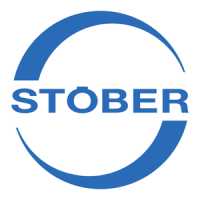
Do you have a question about the Stober POSIDRIVE FDS 5040 and is the answer not in the manual?
| Model | FDS 5040 |
|---|---|
| Control Mode | Servo control |
| Protection Class | IP20 |
| Communication Interface | CANopen, EtherCAT, PROFINET |
| Series | POSIDRIVE FDS 5000 |
| Cooling Method | Forced Air Cooling |
Specifies required qualifications and occupational roles for personnel involved in handling the devices.
Outlines critical safety precautions and requirements for the installation and electrical connection of the device.
Details safety rules and procedures for commissioning, operation, and service tasks on the inverter.
Covers general specifications, including product key, device version, and environmental data.
Presents detailed electrical specifications for size 0 inverters, including power and current ratings.
Details electrical data for size 0 inverters, covering various models and operating conditions.
Details electrical data for size 1 inverters, covering various models and operating conditions.
Explains how increasing switching frequency affects output current (derating) for different models.
Provides detailed instructions and precautions for installing the inverter within a control cabinet.
Introduces and describes the installation procedures for various available accessories.
Provides a visual overview and labeling of the inverter's terminal connections on front and bottom.
Details the terminal description for single-phase and three-phase power connections.
Specifies recommended line fuses and protection ratings for device and DC link connection.
Provides terminal description and connection guidelines for motor connections, including cable lengths.
Details the terminal description for the ASP 5001 option related to Safe Torque Off function.
Explains connections for motor temperature sensors (PTC/KTY) and motor holding brake control.
Explains the concept and requirements of DC link coupling between inverters.
Covers terminal descriptions for analog and binary signal connections.
Provides information on encoder connections, types, and specifications.
Introduces fieldbus communication options and their prerequisites.
Details the licensing, usage rights, and conditions for the POSITool software package.
Guides the user through creating a new project using an assistant for configuration.
Details the functions of the various buttons available on the POSITool toolbar.
Describes the project view, its contents, and project management functions available in the File menu.
Explains the inverter view, how entries are identified, and how to navigate configuration screens.
Explains how to view, edit, and manage parameters within the POSITool software.
Describes the configuration screen, block structure, and navigation within POSITool.
Describes how parameter levels affect visibility and editability, and how to change them.
Explains how configuration levels determine programming capabilities and access to applications.
Describes establishing serial communication between a PC and MDS/FDS 5000 inverters.
Details the methods for establishing an online connection between POSITool and the inverter.
Explains communication possibilities with SDS 5000 units using Integrated Bus (IGB).
Details the process for adjusting the inverter's IP address to match the PC network connection.
Step-by-step guide on establishing a direct connection between PC and inverter via POSITool.
Explains how to access and interpret the fault memory, which records the last 10 faults.
Describes how to use the free parameter list for monitoring and changing parameters.
Details the Scope function for recording parameter progress and analyzing data.
Covers importing and exporting parameter values to/from text files for archiving and transfer.